Honeysuckles are a large family of plants that includes both deciduous and evergreen species. The blooming season for honeysuckle varieties can last throughout the summer, depending on their native range. Some varieties will bloom in May or June while others will wait until late summer or fall to flower.
If you’ve got a honeysuckle vine in your yard, you might be wondering when it will bloom. And if it’s not in bloom now, how long do I have to wait? In this post, we’ll look at the different species of honeysuckle that are out there, how often they bloom and what their flowers look like so that next time you find yourself asking these questions, you’ll have answers!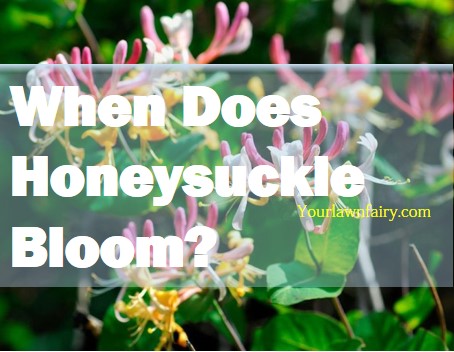
How often do honeysuckles bloom?
There are a few different honeysuckles that grow in the United States, and each of them has its own bloom times. For example, Lonicera sempervirens (known as the trumpet honeysuckle) is famous for blooming during springtime in the months of Mar, Apr, May, Jun while Lonicera japonica (known as the Japanese honeysuckle) tends to bloom in summer. Some varieties, like Lonicera morrowii and Lonicera ×bella, can even be found flowering in the month of May to June! So if you’re looking for a honeysuckle with a specific blooming pattern, it’s best to check with your local nurseries or botanical gardens before making any purchases.
How long do honeysuckle blooms last?
Honeysuckle blooms last anywhere from 1 to 3 months.
The exact length of time depends on a few factors, including the species and variety of honeysuckle you are growing, as well as the local climate.
In general, the longer a honeysuckle’s bloom season lasts, the better your chances are of attracting hummingbirds and other pollinators which is why it’s worth it to make sure your honeysuckle is blooming when it’s most important.
Species of honeysuckle and how long they last
Honeysuckle blooms are a gorgeous addition to any garden. They smell great, attract bees and birds and other pollinators, and last for weeks! Here’s how long honeysuckle blooms last:
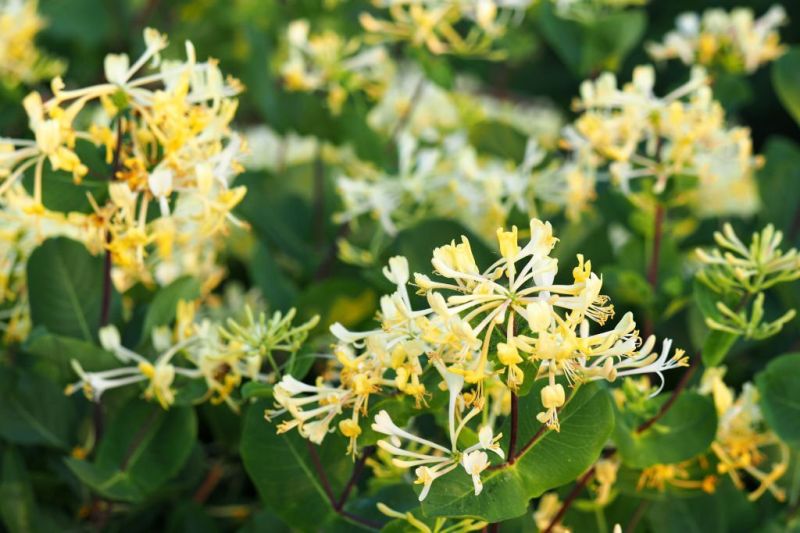
Japanese Honeysuckle
Japanese honeysuckle (Lonicera japonica)
Japanese honeysuckle, Lonicera japonica, is a perennial vine that blooms in late May to early June. It grows best in USDA Hardiness Zones 4-8. This plant has small white flowers that are sweetly scented, giving off a fragrance similar to lilies or orange blossoms. The flowers attract bees and other pollinators, as well as hummingbirds and butterflies. They also attract people who doesn’t love the smell of honeysuckle?
Honeysuckles bloom on new growth each spring, so you’ll want to cut back old stems after they’ve finished flowering (usually around September). If you don’t trim your honeysuckle back every year after it blooms, it will become very woody and not flower again until next spring. You can cut back your honeysuckle with shears or a pruning saw, depending on how much space you have for the plant.
Bell’s honeysuckle (Lonicera x bella)
Bell’s honeysuckle, Lonicera x bella, is a perennial vine that blooms in May to early June. It grows well in zones 4-8, and it is best planted in areas that are sunny and have well-drained soil. The plant is known for its fragrant flowers and its ability to attract hummingbirds and butterflies.
This perennial plant can grow up to 20 feet tall and has small green leaves that resemble maple leaves. The stem of this plant is woody and thick, so it is not very flexible when you try to bend it. You will find bell’s honeysuckle growing in open areas like woods or fields, as well as along roadsides.
The flowers are usually pollinated by hummingbirds or bees because they have an abundance of nectar inside them which attracts these insects to come closer so they can drink from them. The fruits produced by this plant are edible and taste like berries when eaten raw but should be cooked before eating if used for cooking purposes because they contain high amounts of toxicity which can cause vomiting if consumed raw due to their poisonous nature.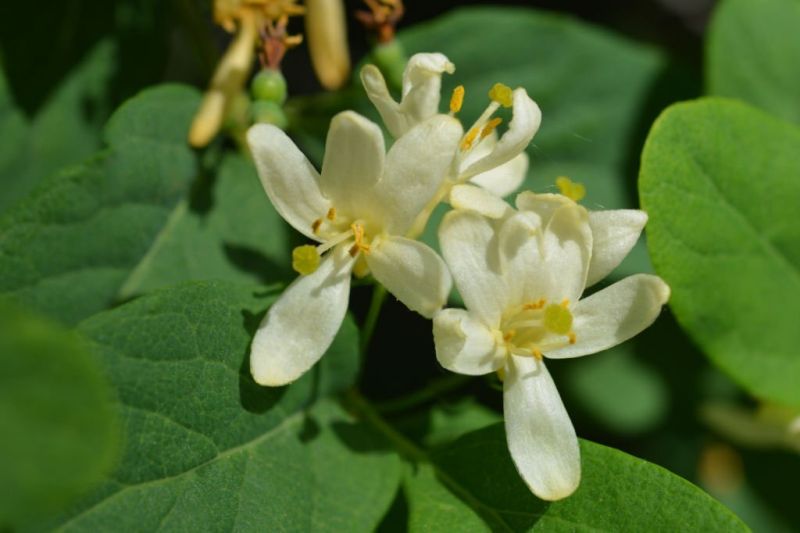
Morrow’s honeysuckle (Lonicera morrowii)
Morrow’s honeysuckle (Lonicera morrowii) is a deciduous vine that can grow 6-8 feet tall and produces fragrant, tubular, white flowers that bloom during May and June. It is native to Japan, Korea and can be found growing in zones 3-8.
Morrow’s honeysuckle has yellowish-green leaves that are narrow, pointed and slightly curved, with a serrated edge. The stems of this plant can be either green or red, depending on the variety. The flowers are usually white but can occasionally be pink or purple. They have five petals and are tubular in shape with a slender throat that emits a sweet fragrance when they open in the morning hours. The fruits are one-seeded drupes that ripen to brown in late summer and fall.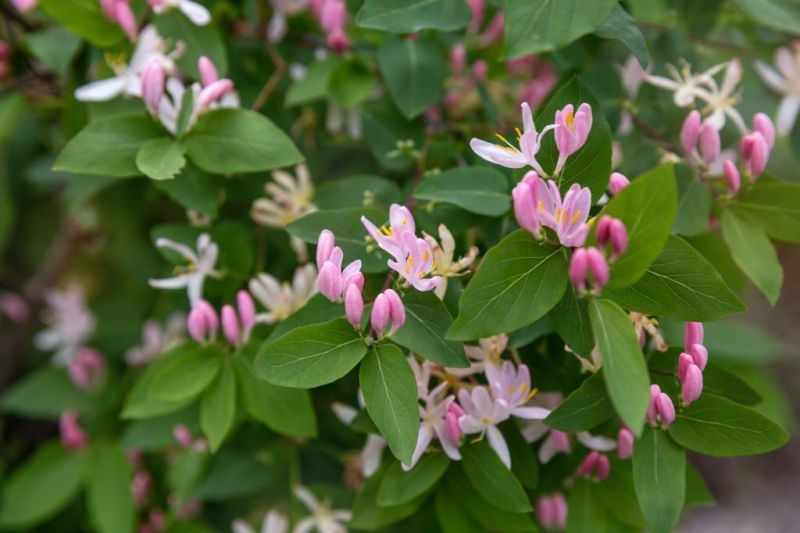
Tatarian honeysuckle (Lonicera tatarica)
Tatarian honeysuckle (Lonicera tatarica) is a hardy deciduous vine that produces fragrant flowers from mid- to late spring. The blooms are pinkish, tubular, and clustered together. The plant grows 6 to 15 feet tall and wide and is a versatile choice for an ornamental garden or a decorative fence. This plant does best in zones 3 through 8.
Tatarian honeysuckle blooms during the months of April and May. The flowers are produced on new wood, so pruning them back after they bloom will encourage more growth and more blooms. The plant is pest-free, but it can be susceptible to fungal diseases such as anthracnose or powdery mildew if not kept well-watered throughout the growing season.
Honeysuckle Pests and Diseases
Honeysuckle plants can be susceptible to a variety of pests and diseases. If you want to keep your honeysuckle healthy, it’s important to know what these are and how to prevent them from affecting your plant.
Pests
Honeysuckle plants are susceptible to several different types of pests, including aphids, spider mites, caterpillars, and scale insects. These pests can cause damage to the leaves, stems, or flowers of your honeysuckle plant.
Aphids: Aphids are tiny insects that suck sap from the stems of plants. They are usually green in color and appear as small dots on leaves or stems. Aphids can also spread disease from one plant to another by injecting viruses into their victims through their mouthparts.
Spider mites: Spider mites are very small arachnids that feed on the undersides of leaves by puncturing them with their fangs and sucking out the sap inside them. This can cause yellow spots on leaves along with webbing between buds and veins on leaf surfaces. Spider mites tend to congregate around leaf joints where they can find shelter from predators such as ladybugs because these areas stay warmer than other areas of the leaf surface during winter months when temperatures drop below freezing levels in northern climates.
Scale insects: These insects tend to cluster on stems and leaves in small groups, where they suck sap from the plant tissue and produce honeydew as waste. You’ll notice these white or brownish-orange insects when they gather on stems or leaves in groups of two or more. They often look like tiny bumps or waxy flakes on your honeysuckle plants’ foliage. You can spray your plants with an insecticidal soap once a week for about three weeks to get rid of scale insects by breaking down their protective outer layer and causing them to dehydrate and die off.
Powdery mildew: Powdery mildew is a fungal disease affecting the leaves of the honeysuckle plant. It causes white or gray spots on the surface of the foliage, which eventually turn brown as they grow larger. This can lead to reduced growth and vigor in plants, as well as weakened stems that are more vulnerable to breakage.
Verticillium wilt: Verticillium wilt is a fungal disease that attacks the vascular tissue in plants, causing them to die. Leaf spots appear on the stems, leaves and flower buds of affected plants. They begin as small reddish brown spots that eventually turn black with age.
Leaf Spots: Leaf spots are caused by fungi (most commonly Cercospora spp.) that invade leaves and stems of honeysuckle plants during periods of warm weather when humidity levels are high. The resulting injury disrupts normal nutrient flow within the plant tissues which may lead to stunted growth or death if left untreated over time.
Root Rot: Root rot occurs when the roots of a plant are damaged by water or airborne pathogens, such as fungal spores. These pathogens infect the roots and cause them to decay, which in turn leads to the death of the plant. If you notice that your honeysuckle plant is wilting, dying, or has yellow leaves with brown tips, then chances are it has developed root rot.
The best way to prevent the development of root rot in your honeysuckle plant is to ensure that its soil is both well-drained and moist at all times. For best results, make sure that there’s plenty of mulch around its base so that any excess water can quickly drain away from its roots rather than pooling around them and causing them harm.
FAQS
What is a honeysuckle plant?
A honeysuckle plant (Lonicera) is a deciduous shrub or vine that grows in temperate climates. Honeysuckle plants are native to Europe and Asia, but they have been widely introduced and naturalized in North America, Australia, New Zealand and South Africa. In the United States, the most common species of honeysuckle is Lonicera japonica. There are about 180 species of honeysuckle. The most common varieties are Lonicera sempervirens, Lonicera japonica, and Lonicera caprifolium.
Honeysuckle flowers produce a sweet nectar that attracts bees and other insects. The flowers themselves are also eaten by some birds. The leaves of some varieties of honeysuckle are edible when cooked as spinach substitutes.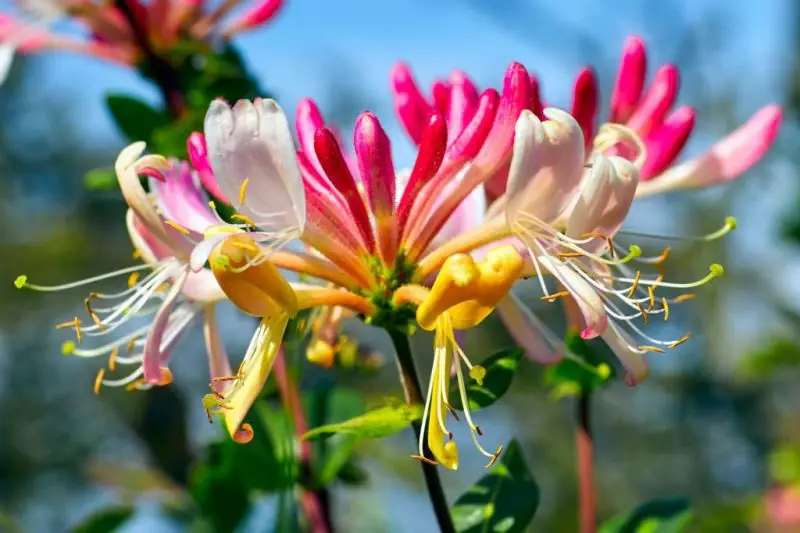
What Colors Can I Expect Honeysuckle Blossoms?
Honeysuckle blooms have a variety of colors that can be yellow, white or red. Honeysuckle flowers are usually white or yellow but can be found to have other colors such as red. The most common color you will see on honeysuckle shrub is white and the scent they give off is sweet and fragrant.
How do I care for my honeysuckle plant?
Honeysuckle plants need full sun or partial shade, so you’ll want to make sure they receive at least six hours of direct sunlight per day during the summertime months (May through September). If they don’t get enough sun exposure, they will produce fewer flowers than usual. To ensure proper growth and flowering, water your honeysuckle when it feels dry below the surface of the soil (about once every two weeks). After each watering session, make sure there is no standing water left over in it.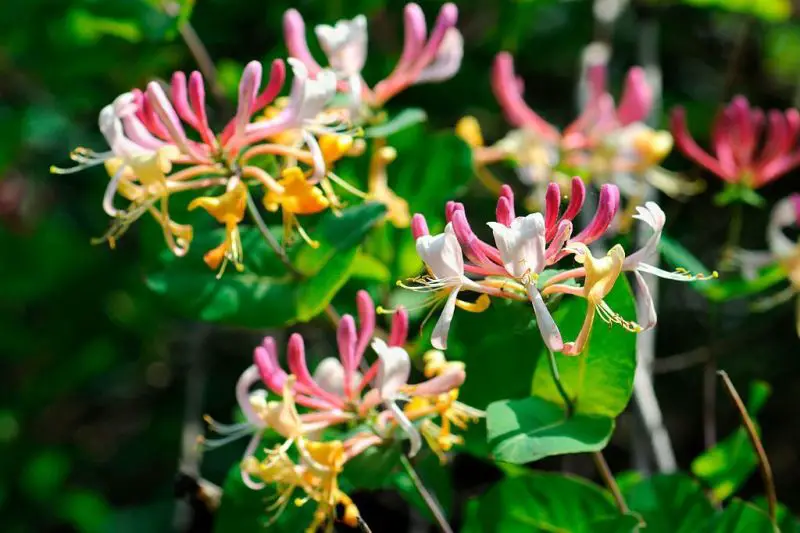
How often do I need to water my honeysuckle plant?
The amount of water your plant needs will depend on where you live and the weather conditions at the time of year. If you’re growing it in a pot with soil, keep the soil moist but not soaking wet.
What causes the honeysuckle plant to bloom?
The honeysuckle is a flowering plant that can grow in a variety of climates and soil conditions. The blooming period for this plant depends on the variety. Some honeysuckles may bloom throughout the spring, while others only bloom in the summer months.
What is the best time to plant honeysuckle?
The best time to plant honeysuckle is in the late fall. In the spring, you can cut back your plants to about 6 inches above ground level and remove any dead or damaged branches. You can also trim back branches by about 2 inches in early summer. This will help your honeysuckle bush grow more vigorously.
How long does it take honeysuckle to bloom?
The blooming time will vary depending on the type of honeysuckle. Some varieties can take up to three years to bloom, while others flower within one year.[su_youtube url=”https://www.youtube.com/watch?v=D5JINvr9URM” width=”500″ height=”360″]
Conclusion
The Honeysuckle Bloom is a beautiful, fragrant flower that can be seen throughout the world. It is a symbol of spring, and many people love to have them in their gardens. There are many different species of honeysuckle that bloom at different times, so if you’re interested in planting one in your garden, it’s important to know when each one will be blooming so that you can choose one that fits your needs.
Hopefully this guide has been helpful in helping you determine when you can expect your honeysuckle to bloom, and how long its blooms will last. If you have any questions about this information, please feel free to reach out!
Also Read: Why Is My Oxalis Drooping & How To Fix It

